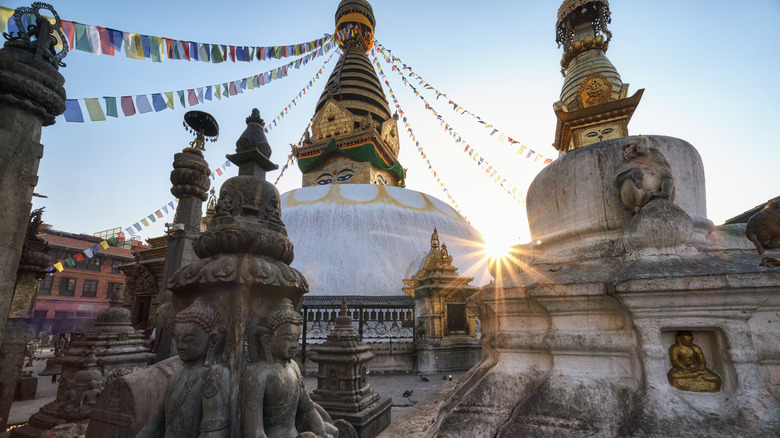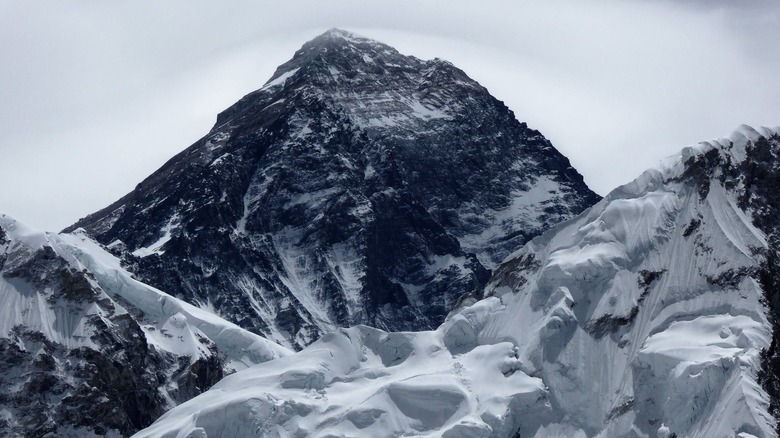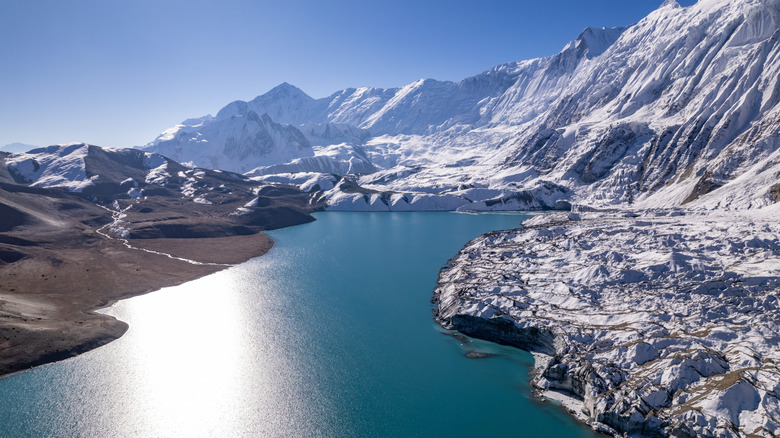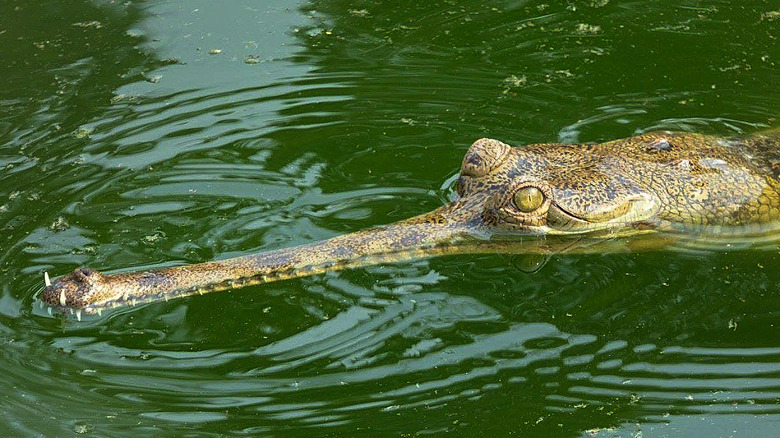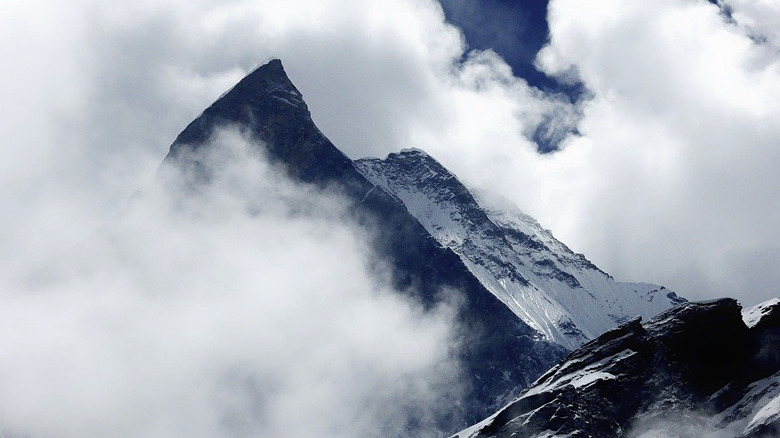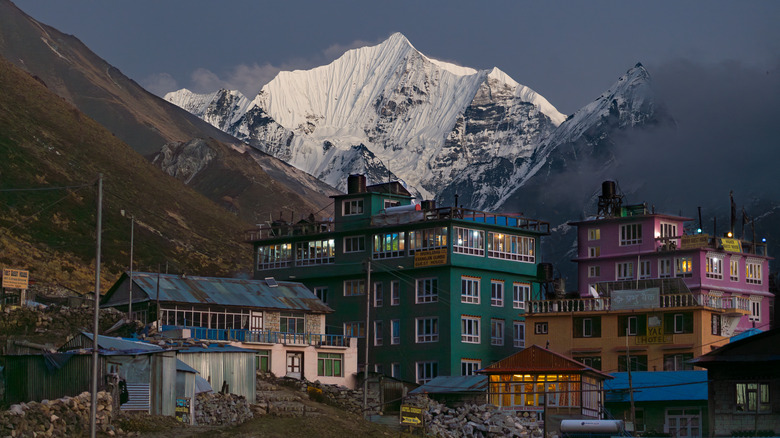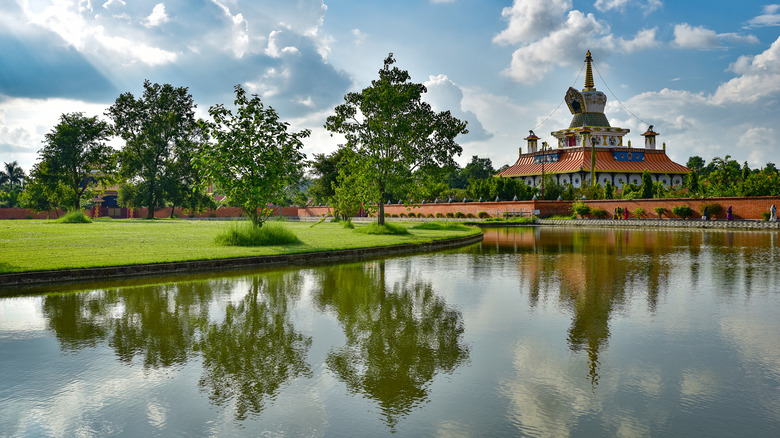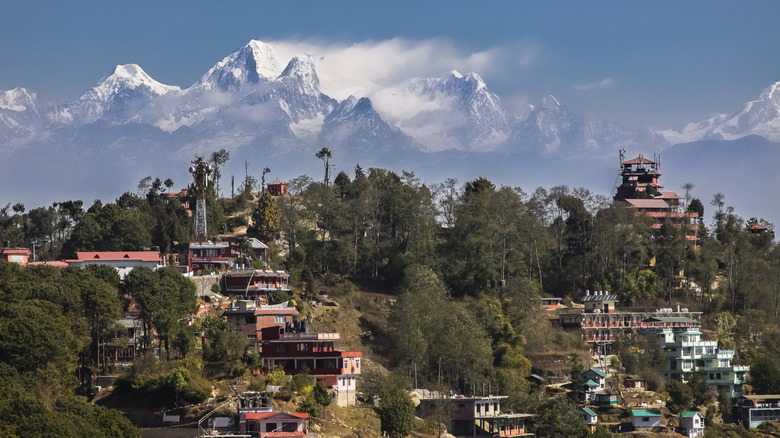Nepal's 10 Best Destinations To Take Beautiful Pictures
Nepal is a country of contrasts, and it's one of the most unique places on Earth for photography. Whether you are carting around a heavy DSLR and all the lenses, or you've opted to go compact by investing in a premium smartphone, this country delivers photo opportunities that defy belief. Within just 100 miles or so, the country's terrain climbs from just 200 feet in its subtropical lowlands all the way up to 29,000 feet at the summit of Sagarmatha — that's Mount Everest to you and me. This extreme elevation range means Nepal has an extraordinary variety of ecosystems, from tiger-inhabited forests to high peaks where snow leopards roam. Better yet, it's all dominated by the world's greatest mountain range: the mighty Himalayas.
For photographers, the post-monsoon months of September through December bring the best clarity. During this time, trails cut through flower-filled valleys and the electric blue skies are perfect for alpine shots. Alternatively, the spring months of March through May bring the famed rhododendrons as they blanket the hillsides in color and create ready-made foregrounds for framing the peaks.
Meanwhile, in the cities, you can shoot everything from monks in their saffron robes crossing ancient squares to bustling markets and centuries-old temples, while wild rhinos and elephants await in national parks. To help you plan, we've handpicked 10 of Nepal's best picture-taking spots. Consulting local photography blogs and websites, this list of standout destinations highlights the views travelers rave about most — so you can confidently grab your camera or smartphone and go frame those moments.
The three major Durbar Squares (Kathmandu, Patan, and Bhaktapur)
The word "Durbar" translates to "royal palace" in English, and there are three main squares where you can see these highly photogenic landmarks: Kathmandu, Patan, and Bhaktapur. These former Newar city states were once rivals before unification in the late 18th century. Nowadays, the three practically join onto each other, and traveling between them is relatively simple.
Kathmandu Durbar Square is the easiest to visit. It sits in the center of the capital and has plenty of attractions to keep shutterbugs busy — including the Kumari Ghar compound. This building is the residence of the Kumari, a child deity said to be the living embodiment of the goddess Taleju. Visitors are welcome to explore its ornate courtyard, as well as the many other medieval buildings in the square. If you're lucky, you may even get a glimpse of the Kumari at certain times of the day, but note that photography is strictly forbidden.
Just south of Kathmandu is the city of Patan, an exquisite showcase of architecture and handicrafts. Patan Durbar Square offers places like Tusha Hiti, a 17th-century royal bath celebrated for its refined Newari design and detailed stonework. Meanwhile, Taleju Bhavani Temple, Mul Chowk, and the central Patan Durbar Square plaza will have you shooting from every angle. Bhaktapur Durbar Square lies roughly 9 miles east of Kathmandu. The area preserves its historic essence with key shooting locations like the 55 Window Palace, which displays elaborately carved timber windows from the 1700s; the Golden Gate; and Nyatapola Temple, the nation's tallest pagoda.
Major temples and stupas in Kathmandu
Kathmandu has many temples and stupas awaiting the keen eyes of photographers. The most photogenic are Swayambhunath, which sits atop a hill and has sweeping views of the city; Boudhanath, the largest dome-shaped Buddhist stupa in Nepal; and Pashupatinath, Nepal's biggest Hindu temple complex. Hindu and Buddhist structures share the same grounds at Swayambhunath, giving photographers the opportunity to capture both religions. Holy monkeys roam freely around the site if you're looking for something a little livelier, while the painted Buddha eyes on the stupa give the temple its signature image. The climb up to the top can be tiring, but try to arrive as early as possible for the best light and the cleanest air.
The 118-foot-tall Boudhanath Stupa is a towering white dome ritually looked after by monks, with their instantly recognizable maroon and saffron robes contributing to color-rich photos during festivals and prayer times. The stupa is also adorned with prayer flags fluttering in the wind, religious scroll paintings, traditional artwork, butter lamps, and burning incense sticks, which all make for atmospheric shots.
About a half-hour walk away, sitting on the Bagmati River, is Pashupatinath, Nepal's biggest Hindu temple complex. Within the grounds, you'll find photogenic shrines, stone Shiva lingams, and sacred sculptures, while sadhus — Hindu ascetics devoted to spiritual practice — wander around with their ash-covered bodies and dreadlocked hair. Coincide your visit with the Teej Festival in August, where the Goddess Parvati's devotion to Lord Shiva is honored, or the Maha Shivaratri Festival from February to March, which can attract up to 2 million pilgrims. Open-air cremations also take place at Pashupatinath, and visitors are permitted to witness them. Please show respect and understand that photographing the cremations is strictly forbidden.
Pokhara
Phewa Lake is the centerpiece of Pokhara and the spot where most tourists stay. For much of the year — especially in the peak season from October to November — you can see the Annapurna range and the twin-pronged Machhapuchhre (Fishtail Mountain) reflecting on the lake's surface. The lake is surrounded by forested slopes and decorated by colorful doonga boats floating across its reflections. Visitors can paddle one out to Tal Barahi Temple, which sits on a small island mid-lake.
You can use the same boat to get to the rugged trail that leads up a hill to the World Peace Pagoda for commanding views over the city, the lake, and the Himalayan skyline. The brilliant white dome stands tall at 115 feet and features four symbolic Buddha statues around its upper level. On a clear day, you can shoot the pagoda contrasting against blue skies with those Himalayan Titans in the background.
For more epic mountain scenery in the Pokhara area, try Sarangkot — though be warned it's a fairly tough climb up stone steps and forested hillsides to get to the open views of those dramatic mountains. If that isn't what you're looking for, you can also take a taxi. Either way, the view is the same, stretching all the way from Dhaulagiri — towering tall at nearly 27,000 feet as the seventh-highest peak in the world — across to Machhapuchhre and Lamjung Himal. There are good lodgings up there, too, meaning you can rest comfortably before shooting the early sunrise.
Mount Everest Base Camp Trek
The journey to Everest Base Camp (EBC) begins with a landing at one of the world's scariest airport runways, which is an absolute thrill in itself, and ends with you straining your neck up at the world's highest peak. In between, it's a photographer's dream. However, it's a tough old hike, and, unless you're a professional, you might not want to carry all those lenses and equipment — and you also shouldn't burden individual porters with excessive loads. That said, hire extra support if you're carrying a lot of gear.
From the airport in Lukla, you'll begin the epic two-week trek through alpine meadows and jagged peaks, stopping at villages, lakes, and high-altitude monasteries for some once-in-a-lifetime photo ops. At Namche Bazaar, an amphitheater-like village set on a cliff at 11,286 feet, you'll be constantly shooting Sherpa village life. You'll get your first shots of Everest around here, too. After Namche, you can take a detour to Gokyo Ri, where you'll find a glacial-fed turquoise collection of some of the world's most breathtaking lakes. From the top of Gokyo Ri, you can capture a panorama of Everest, Makalu, and Cho Oyu, the world's highest, fifth-highest, and sixth-highest peaks.
Then, at Tengboche Monastery, you'll have monks, butter lamps, and prayer rituals in front of the pyramid-shaped Ama Dablam and Everest. Just before Base Camp is Kala Patthar, a tough climb up to almost 18,500 feet where you'll get some of the most incredible views of the colossal giant with Lhotse and Nuptse standing guard. If you start the climb early enough, you can catch golden light hitting the summit of Everest about 20 minutes after the sun breaks the horizon. If you have any energy left, it's onward and upward to the expedition tents at EBC huddled at the foot of the Khumbu Glacier.
Annapurna Circuit Trek
The Annapurna Circuit Trek (ACT) is considered one of the most incredible hiking trails in Nepal despite the construction of a road that follows large portions of it. Usually, it takes two to three weeks to complete, although the road now means shorter trips are possible. However, with its numerous side trails, you could easily spend your entire visa duration wandering this area. That said, many skip the initial sections and take a jeep directly to Chame or Manang — although going directly to the latter is a dangerous choice due to the altitude, per the Wilderness Medical Society. If you begin the trek near Besishahar, you'll enjoy fewer crowds and the chance to photograph the full transition of the terrain.
Climbing from subtropical valleys, the ACT culminates in a snowy pass at almost 18,000 feet. In between, you'll enjoy highlights like Bahundanda, a village that sits atop a ridge overlooking cascading rice terraces and the nearby Marsyangdi River, which cuts through high cliffs with churning whitewater fed by numerous waterfalls. You'll also pass through pine forests, alpine meadows, and striking rock formations with the ever-changing mountain views shifting before your eyes.
Eventually, you'll reach Manang, where there are side trails to Ice Lake (Kicho Tal) and the glacial Gangapurna Lake. There's also the challenging hike to Tilicho Lake, located at over 16,000 feet. Thorong La Pass is the circuit's highest point before you descend down into desert country in Mustang. Many people take a jeep back down this side of the circuit, and some even take a flight from Jomsom. Just keep in mind that doing so will mean you miss out on spots like Poon Hill, which draws big crowds for sunrise views of Annapurna and Dhaulagiri.
Chitwan National Park
You can warm up in the southern lowlands of Nepal at Chitwan National Park, which just happens to be one of the best spots in Asia for wildlife photography. A 360-square-mile park that encompasses grasslands, forests, wetlands, and river systems, the area is home to around 700 species of wildlife — including Bengal tigers, wild elephants, one-horned rhinos, nocturnal sloth bears, narrow-snouted gharials, and leopards — while more than 500 species of birds make it a birdwatcher's paradise. Migratory birds arrive in droves for epic shots during the cooler months between October and April. These months also offer thinner vegetation for other sightings, and animals congregate in numbers at water sources, giving you countless opportunities for fantastic shots.
The rhinos are easily photographed, and there are about 700 in the park after being brought back from the brink of extinction. They graze the grasslands and wallow in mud pools, and you'll even catch some wading in the Rapti River at sunset. Alternatively, early morning, coupled with the dawn mist, is also prime time for photographers seeking break-of-day atmosphere as the jungle awakens.
The Bengal tiger is seen less frequently, but you might see paw prints in the mud or hear the panicked calls of deer in the distance to add a bit of suspense to your tour. And with that, you might agree that a jeep safari is preferable over guided walking tours. These animals are dangerous, and fatal encounters have happened.
Annapurna and Machhapuchhare Base Camps
The Annapurna Base Camp Trek (ABC) is comprised of both the Annapurna and Machhapuchhre Base Camps (MBC). The trek winds its way through spring forests and Gurung villages into valleys where monasteries and temples are quietly dwarfed by giant peaks. Like other primary treks in Nepal, photographers will appreciate the conditions most from around mid-September to mid-November, although those hillsides burn with the pink, red, and white blooms of rhododendrons from late March through mid-April.
The MBC comes first. It's a five- to seven-day hike to get there — or longer if you wish — and you'll arrive at ABC a couple of hours later. Not a particularly high-altitude trek by Nepalese standards, MBC sits at 12,139 feet, directly beneath sublime views of the fishtail summit. Its twin peaks remind one of a giant fish plunging headfirst into the earth, with the shape amplified by shimmering ice on its slopes. This mountain has never been conquered. Hindus believe that Lord Shiva meditates up there, so not a soul is permitted to defile its sacred ground. At sunrise and sunset, it's ablaze with gold and crimson, and these are the perfect moments to get your camera out.
Make your way to ABC before dawn to see a ring of Himalayan giants ignite into a pre-sunrise alpenglow. ABC is circled by several major peaks, dominated by Annapurna I at 26,545 feet. The base camp itself sits at 13,550 feet — and it gets cold, so keep your batteries warm and make sure you protect your eyes from the bright snow with a solid pair of UV-blocking sunglasses. On your way back down, seek out the numerous hot springs to soak your aching legs.
Langtang Valley
The Langtang Valley Trek sees lighter traffic than the Everest and Annapurna routes, which may appeal more to photographers. While you may be initially more inclined to see the summits that tower over those more popular paths, if you're on a return trip to Nepal, this trek will soon hold a special place in your heart. Many villages along the valley were flattened when the 2015 earthquake devastated the country. Yet, within months, the locals hammered together new homes, lodges, and trails — and the results are inspirational. In fact, there's a sense of resilience in this valley that just beckons photographers to record it.
The ride to Langtang Valley takes roughly six to seven hours from the capital. It cuts through lush gorges and villages, while Himalayan peaks — including Langtang Lirung, rising steeply to about 23,700 feet — are ever-present from every side.
The village of Kyanjin Gompa, a hardy settlement clinging to dry, rocky slopes, sits below Langtang Lirung and Dorje Lakpa under an often cloudless blue sky. Meanwhile, a climb up to Kyanjin Ri will offer sweeping panoramic shots from all sides. Sunrise works best, when golden light sweeps across the snowfields and the peaks start to appear out of the dark. Tsergo Ri, at around 16,350 feet, is the trek's highest viewpoint, and the perfect spot to witness Langtang Lirung, Yala Peak, Dorje Lakpa, and, when the air's clear, Shishapangma (26,335 feet) across the border in Tibet.
Lumbini
Lumbini is considered "The Birthplace Of Buddha," and it's traditionally recognized as where Siddhartha Gautama was born more than 2,500 years ago in the year 623 BC. A pillar erected in 249 BC officially records the birth at this location, while archaeologists discovered a commemorative stone under the Maya Devi Temple in 1995 that ended centuries of argument between India and Nepal about his actual birthplace.
Notable archaeological zones include a sacred pond that marks the spot where Queen Maya Devi was said to bathe just before giving birth. There are also the Maya Devi Temple ruins — with brick layers dating from the 3rd century BC to the present day — as well as Buddhist monasteries from the 3rd to 5th centuries AD, and stupas spanning the 3rd century BC through the 15th century AD. Buddhist nations such as Thailand, Myanmar, Japan, and Sri Lanka have all contributed monasteries and temples that reflect their own styles.
That said, there are plenty more photography opportunities beyond religious buildings. The world's tallest flying bird, the sarus crane, which stands at up to six feet tall, frequents the grounds. Meanwhile, the full moon festival of Buddha Jayanti, which commemorates the birth and life of Buddha, draws pilgrims in huge numbers.
Nagarkot
The hill station of Nagarkot sits at an elevation of 7,200 feet and is a great spot for mountain photography in the winter months, when high-altitude trails are either closed or too cold. Once a military fort that watched over rival kingdoms, it later became the summer retreat for the Nepali royal family to escape the heat. Nowadays, it pretty much focuses on tourism. The village is filled with hotels and guesthouses catering to all budgets, and most visitors travel there for the sweeping Himalayan views — especially of the Langtang range and, on exceptionally clear days, distant glimpses of Everest.
On a clear morning, you might bear witness to several peaks, including Langtang Lirung, Dorje Lakpa, Gaurishankar, Shishapangma, and the almighty Everest. This last one is, of course, the highest of them all — although, as mentioned earlier, only a small section of it is ever visible. As such, Nagarkot is often considered one of the nearest road-accessible viewpoints from Kathmandu. Pro tip: One of the best vantage points is just a short walk from the village's police checkpoint.
Sunrise viewing is the main event, but stick around a few days and you'll have plenty more activities to fill your time. There are day hikes through forest trails, including a path up to a lookout tower and another to Changunarayan Temple, where you can explore local culture, encounter wildlife, and visit the Buddha Peace Park.
Methodology
In order to identify Nepal's most photogenic locations, we combined the author's firsthand experience with insights from local photography blogs and specialist websites. The goal was to highlight spots that consistently deliver great images — whether you're shooting towering Himalayan peaks, serene lakes, wildlife-rich plains, or historic cultural sites.
Additionally, we also factored in practical details — like how easy a place is to reach, which seasons offer the best visibility, and where the most reliable viewpoints are — so readers can plan their shots with confidence and make the most of their time on the ground. In the end, we settled on 10 standout destinations that truly capture the essence of Nepal and offer an exciting mix of subjects.


